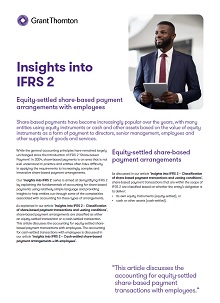
As discussed in our article 'Classification of share-based payment transactions and vesting conditions’, share-based payment transactions that are within the scope of IFRS 2 are classified based on whether the entity’s obligation is to deliver:
- its own equity instruments (equity-settled), or
- cash or other assets (cash-settled).
Definition
A share-based payment transaction in which the entity:
-
receives goods or services as consideration for its own equity instruments (including shares or share options), or
-
receives goods or services but has no obligation to settle the transaction with the supplier.
The most common equity-settled share-based payment transactions are grants of shares and share options. Share options are awards where employees are granted a right (but not an obligation) to subscribe to an entity’s shares at a fixed or determinable price, for a specified period of time.
Transactions where either the entity or the counterparty has the choice to settle in equity instruments or in cash or other assets are discussed in our article, ‘Employee share-based payment agreements with settlement alternatives’.
General principles
For equity-settled share-based payment transactions with employees, the services received are measured on the grant date at fair value. The value of the services provided by employees is measured indirectly by reference to the fair value of the equity instruments granted, rather than at the fair value of the services received, as there is a presumption that the employee services received for particular components of an employee’s remuneration package cannot be measured reliably. IFRS 2 therefore assumes that the fair value of the employee services is equal to the fair value of the equity instruments on the grant date. For equity-settled share-based payments, although the services may be provided over a period of time, the fair value is measured only once at the grant date (unless the share-based payment arrangement is subsequently modified).
The entity recognises the services received (ie the share-based payment cost) as the employee provides the service (starting from when the employee commences providing the service), with a corresponding increase in equity. When the employee is required to complete a specified period of service before the equity instruments vest, the services are recognised over the vesting period. However, if the award vests immediately, it is assumed that the employee has already provided the service and the expense is recognised immediately.
Definition
-
The modified grant-date method is a method whereby vesting conditions are taken into account by adjusting the number of equity instruments included in the measurement of the transaction amount so that, ultimately, the amount recognised for goods or services received as consideration for the equity instruments granted is based on the number of equity instruments that eventually vest.
As discussed in our article ‘Classification of share-based payment transactions and vesting conditions’, share-based payment awards may include conditions that determine whether an employee is entitled to receive the payment (ie vesting and non-vesting conditions). The modified grant-date method considers these conditions as follows:
- Non-vesting conditions and market performance conditions are taken into account when estimating the grant-date fair value of the equity-settled share-based payment. There is no subsequent true-up for a failure to meet these conditions. The share-based payment cost is recognised regardless, assuming that any service conditions and non-market performance vesting conditions are met, even though the employee will never receive the share-based payment.
- Conversely, service conditions and non-market performance vesting conditions are not taken into account when estimating the grant-date fair value of the equity-settled share-based payment. Instead, non-market vesting conditions are taken into account by adjusting the number of equity instruments (ie awards) that are expected to vest. The entity does not recognise amounts relating to awards that are not expected to and ultimately do not vest because of a failure to satisfy a non-market vesting condition.
This accounting method is called the modified grant-date method, because the number of equity instruments used to calculate the transaction amount is adjusted to reflect the outcome of service and non-market performance vesting conditions, but no change is made to the grant-date fair value.
Reflecting conditions in the grant-date fair value
Determining the grant-date fair value is discussed in the article, ‘Basic principles of share-based payment arrangements’. Reflecting the probability of meeting market performance conditions (eg achieving a specified share price) in the grant-date fair value is accomplished by using one of the valuation models discussed in that article. Reflecting the probability of meeting a non-vesting condition that does not relate to future share prices is generally not incorporated into the valuation model as these conditions can often be difficult to quantify, unless they are based on some form of market-based data. Instead, an entity needs to determine an appropriate method for incorporating the non-vesting condition into the grant-date fair value.
Reflecting conditions in the awards expected to vest
Estimating the impact of service and non-market performance conditions is achieved by estimating the number of equity instruments for which the conditions are expected to be satisfied. Initially, an entity makes its best estimate of the number of awards for which the conditions are expected to be satisfied, which may be any number between zero (ie conditions will not be satisfied) and the total number of instruments granted (ie conditions will be completely satisfied). At each subsequent reporting date, the entity revises, or trues-up, this estimate based on new information (eg some employees have left and therefore will not satisfy the service condition). On the vesting date, the entity revises the estimate to equal the number of equity instruments that ultimately vests.
At the end of the vesting period, this results in the cumulative share-based payment cost recognised by the entity being:
- The number of equity instruments for which service and non-market performance conditions have been satisfied, multiplied by
- The grant-date fair value of those equity instruments, which incorporated the impact of non-vesting and market performance conditions.
As noted in the summary table on page three, market conditions are reflected in the grant-date fair value and are not subsequently adjusted if the market condition is not met. Therefore, an entity recognises the services received from employees that meet all other vesting conditions, even if the market condition is not met. For example, if an employee receives a share option award and meets the required service condition, but the entity does not meet the share price target associated with the award, the entity still recognises the services received from the employee at the grant-date fair value.
A change in estimate for the likelihood of satisfying service or non-market vesting conditions is not adjusted consistently with typical changes in estimates (ie prospective application). Instead, the charge (or credit) in profit or loss for the period is the cumulative amount determined if that revised estimate had been used from the beginning of the vesting period, less the cumulative amount charged in the previous period.
Once an equity-settled share-based payment award has vested, no further accounting adjustments can be made to the cost of the award. For example, where options vest but are never exercised by the option holder, IFRS 2 requires that the cost of those options still be recognised. However, this does not preclude the entity from making a transfer between components of equity upon expiry of the award.
What if fair value of equity instruments cannot be measured reliably?
IFRS 2 assumes that the fair value of equity instruments in equity-settled share-based transactions with employees can be measured reliably. However, the standard does acknowledge that there may be rare cases where the fair value cannot be measured reliably. In these instances, the entity should use the intrinsic value method to value the instruments:
- initially, on the grant date,
- subsequently, at the end of each reporting period, and
- at the settlement date (ie the options are exercised, forfeited or expire).
Definition
-
The difference between the fair value of the shares to which the counterparty has the (conditional or unconditional) right to subscribe or to which it has the right to receive, and the price (if any) the counterparty is (or will be) required to pay for those shares.
Changes in the intrinsic value are recognised in profit or loss. The intrinsic value method is generally preferable because the alternative approach is much more burdensome for preparers and requires the use of the market value of the equity instrument not only at inception but also at each reporting date.
How do ‘good leaver’ clauses impact the accounting?
Share-based payment arrangements usually contain clauses that indicate that the award is forfeited if an employee leaves before the service condition is met. These arrangements may also contain ‘good leaver’ clauses, which describe the circumstances under which some or all of the share-based payment award granted to an employee is not forfeited for leaving the entity prior to completing the service condition. This is often the case when an employee leaves due to circumstances beyond their control, such as retirement, death, or disability. An employee that leaves under these circumstances may be treated like an employee that has fulfilled the service condition, either in full or on a pro rata basis (ie up to the date they leave the entity). As a result, their service period ends on the date that they are entitled to receive the share-based payment, thereby impacting the vesting period and potentially the grant-date fair value (ie if the expected exercise date differs as a result of the shorter vesting period).
How we can help
Our ‘Insights into IFRS 2’ series is aimed at demystifying IFRS 2 by explaining the fundamentals of accounting for share-based payments using relatively simple language and providing insights to help entities cut through some of the complexities associated with accounting for these types of arrangements.
We hope you find the information in this article helpful in giving you some detail into aspects of IFRS 2. If you would like to discuss any of the points raised, please speak to your usual Grant Thornton contact or your local member firm.



